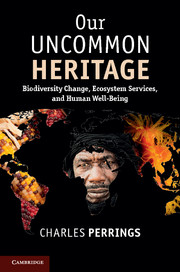Book contents
- Frontmatter
- Dedication
- Contents
- List of figures
- List of tables
- Foreword
- Preface
- List of acronyms
- 1 Biodiversity change
- Part I Diagnosing the biodiversity change problem
- 2 Biodiversity in the modern world
- 3 Biodiversity and ecosystem services
- 4 Biodiversity loss, sustainability, and stability
- 5 Biodiversity externalities and public goods
- 6 Poverty alleviation and biodiversity change
- 7 Globalization: trade, aid, and the dispersal of species
- Part II The search for solutions
- Index
- References
6 - Poverty alleviation and biodiversity change
Published online by Cambridge University Press: 05 June 2014
- Frontmatter
- Dedication
- Contents
- List of figures
- List of tables
- Foreword
- Preface
- List of acronyms
- 1 Biodiversity change
- Part I Diagnosing the biodiversity change problem
- 2 Biodiversity in the modern world
- 3 Biodiversity and ecosystem services
- 4 Biodiversity loss, sustainability, and stability
- 5 Biodiversity externalities and public goods
- 6 Poverty alleviation and biodiversity change
- 7 Globalization: trade, aid, and the dispersal of species
- Part II The search for solutions
- Index
- References
Summary
Stating the problem
The Brundtland Report made a strong connection between environmental change and poverty. It argued that since poverty was both a cause and an effect of global environmental change it was “futile to attempt to deal with environmental problems without a broader perspective that encompasses the factors underlying world poverty and international inequality” (World Commission on Environment and Development 1987). The report asserted that there was a positive feedback between poverty and environmental degradation:
Many parts of the world are caught in a vicious downwards spiral: Poor people are forced to overuse environmental resources to survive from day to day, and their impoverishment of their environment further impoverishes them, making their survival ever more difficult and uncertain . . . the poor and hungry will often destroy their immediate environment in order to survive: They will cut down forests; their livestock will overgraze grasslands; they will overuse marginal land; and in growing numbers they will crowd into congested cities. The cumulative effect of these changes is so far-reaching as to make poverty itself a major global scourge.
(World Commission on Environment and Development 1987)It also noted the coincidence between poverty and species richness in the tropics, and identified the conversion of forest to agriculture in those regions as the primary cause of the loss of wild-living species. One implication of this is that by addressing the problem of poverty in the tropics, we can simultaneously address the problem of biodiversity loss.
- Type
- Chapter
- Information
- Our Uncommon HeritageBiodiversity Change, Ecosystem Services, and Human Wellbeing, pp. 184 - 213Publisher: Cambridge University PressPrint publication year: 2014

